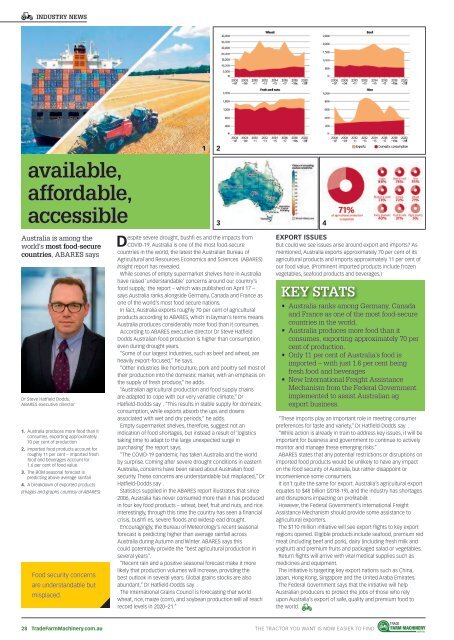You also want an ePaper? Increase the reach of your titles
YUMPU automatically turns print PDFs into web optimized ePapers that Google loves.
INDUSTRY NEWS<br />
available,<br />
affordable,<br />
accessible<br />
Australia is among the<br />
world’s most food-secure<br />
countries, ABARES says<br />
Dr Steve Hatfield Dodds,<br />
ABARES executive director<br />
1. Australia produces more food than it<br />
consumes, exporting approximately<br />
70 per cent of production<br />
2. Imported food products account for<br />
roughly 11 per cent – imported fresh<br />
food and beverages account for<br />
1.6 per cent of food value<br />
3. The BOM seasonal forecast is<br />
predicting above average rainfall<br />
4. A breakdown of exported products<br />
(Images and graphs courtesy of ABARES)<br />
Food security concerns<br />
are understandable but<br />
misplaced.<br />
Despite severe drought, bushfi es and the impacts from<br />
COVID-19, Australia is one of the most food-secure<br />
countries in the world, the latest the Australian Bureau of<br />
Agricultural and Resources Economics and Sciences (ABARES)<br />
Insight report has revealed.<br />
While scenes of empty supermarket shelves here in Australia<br />
have raised ‘understandable’ concerns around our country’s<br />
food supply, the report – which was published on April 17 –<br />
says Australia ranks alongside Germany, Canada and France as<br />
one of the world’s most food secure nations.<br />
In fact, Australia exports roughly 70 per cent of agricultural<br />
products according to ABARES, which in layman’s terms means<br />
Australia produces considerably more food than it consumes.<br />
According to ABARES executive director Dr Steve Hatfield<br />
Dodds Australian food production is higher than consumption<br />
even during drought years.<br />
“Some of our largest industries, such as beef and wheat, are<br />
heavily export-focused,” he says.<br />
“Other industries like horticulture, pork and poultry sell most of<br />
their production into the domestic market, with an emphasis on<br />
the supply of fresh produce,” he adds.<br />
“Australian agricultural production and food supply chains<br />
are adapted to cope with our very variable climate,” Dr<br />
Hatfield-Dodds say . “This results in stable supply for domestic<br />
consumption, while exports absorb the ups and downs<br />
associated with wet and dry periods,” he adds.<br />
Empty supermarket shelves, therefore, suggest not an<br />
indication of food shortages, but instead a result of ‘logistics<br />
taking time to adapt to the large unexpected surge in<br />
purchasing’ the report says.<br />
“The COVID-19 pandemic has taken Australia and the world<br />
by surprise. Coming after severe drought conditions in eastern<br />
Australia, concerns have been raised about Australian food<br />
security. These concerns are understandable but misplaced,” Dr<br />
Hatfield-Dodds say .<br />
Statistics supplied in the ABARES report illustrates that since<br />
2006, Australia has never consumed more than it has produced<br />
in four key food products – wheat, beef, fruit and nuts, and rice.<br />
Interestingly, through this time the country has seen a financial<br />
crisis, bushfi es, severe floods and widesp ead drought.<br />
Encouragingly, the Bureau of Meteorology’s recent seasonal<br />
forecast is predicting higher than average rainfall across<br />
Australia during Autumn and Winter. ABARES says this<br />
could potentially provide the “best agricultural production in<br />
several years”.<br />
“Recent rain and a positive seasonal forecast make it more<br />
likely that production volumes will increase, providing the<br />
best outlook in several years. Global grains stocks are also<br />
abundant,” Dr Hatfield-Dodds say .<br />
The International Grains Council is forecasting that world<br />
wheat, rice, maize (corn), and soybean production will all reach<br />
record levels in 2020–21.”<br />
1<br />
2<br />
3 4<br />
EXPORT ISSUES<br />
But could we see issues arise around export and imports? As<br />
mentioned, Australia exports approximately 70 per cent of its<br />
agricultural products and imports approximately 11 per cent of<br />
our food value. (Prominent imported products include frozen<br />
vegetables, seafood products and beverages.)<br />
KEY STATS<br />
• Australia ranks among Germany, Canada<br />
and France as one of the most food-secure<br />
countries in the world.<br />
• Australia produces more food than it<br />
consumes, exporting approximately 70 per<br />
cent of production.<br />
• Only 11 per cent of Australia’s food is<br />
imported – with just 1.6 per cent being<br />
fresh food and beverages<br />
• New International Freight Assistance<br />
Mechanism from the Federal Government<br />
implemented to assist Australian ag<br />
export business.<br />
“These imports play an important role in meeting consumer<br />
preferences for taste and variety,” Dr Hatfield-Dodds say .<br />
“While action is already in train to address key issues, it will be<br />
important for business and government to continue to actively<br />
monitor and manage these emerging risks.”<br />
ABARES states that any potential restrictions or disruptions on<br />
imported food products would be unlikely to have any impact<br />
on the food security of Australia, but rather disappoint or<br />
inconvenience some consumers.<br />
It isn’t quite the same for export. Australia’s agricultural export<br />
equates to $48 billion (2018-19), and the industry has shortages<br />
and disruptions impacting on profitabilit .<br />
However, the Federal Government’s International Freight<br />
Assistance Mechanism should provide some assistance to<br />
agricultural exporters.<br />
The $110 million initiative will see export flights to key export<br />
regions opened. Eligible products include seafood, premium red<br />
meat (including beef and pork), dairy (including fresh milk and<br />
yoghurt) and premium fruits and packaged salad or vegetables.<br />
Return flights will arrive with vital medical supplies such as<br />
medicines and equipment.<br />
The initiative is targeting key export nations such as China,<br />
Japan, Hong Kong, Singapore and the United Araba Emirates.<br />
The Federal Government says that the initiative will help<br />
Australian producers to protect the jobs of those who rely<br />
upon Australia’s export of safe, quality and premium food to<br />
the world.<br />
28 Trade<strong>Farm</strong><strong>Machinery</strong>.com.au THE TRACTOR YOU WANT IS NOW EASIER TO FIND

















